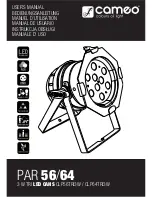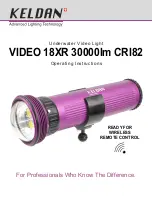
Betonbecken mit Folienauskleidung
Foil lined concrete pools
Bassin en béton revêtu d'une feuille plastique
• Betonbecken mit Folienauskleidung
Nach Entfernen der Schalung Einbaugehäuse
reinigen. Nach dem Einlegen der Folie in das
Becken erforderliche Öffnung und Lochungen
für Schrauben ausschneiden. Die Beckenfolie
muss zwischen den beiden Flanschdichtungen
liegen. Schrauben durch Lochungen von
Flanschring Flanschdichtung – Folie -
zweite Flanschdichtung führen und mit dem
Einbaugehäuse verschrauben. Senkschrauben
fest anziehen.
Leitung durch Leitungsverschraubung und
PVC-Schutzschlauch führen.
Da ein Lampenwechsel oberhalb des
Wasserspiegels erfolgt, ist auf ausreichende
Leitungslänge zu achten.
Leitungsverschraubung fest anziehen.
Leitung um das Leuchtengehäuse wickeln.
Leuchtengehäuse in das Einbaugehäuse
einsetzen und Befestigungsschrauben
gleichmäßig fest anziehen.
• Foil lined concrete pools
After removing the formwork clean the recessed
housing. After inserting the foil in the pool cut
out the necessary opening and the holes for
the screws. The pool foil must be positioned
between the two flange gaskets. Lead screws
through the holes of the flange ring, flange
gasket - foil - second flange ring. Bolt together
the complete unit with the recessed housing.
Tighten counter sunk screws firmly. Lead cable
through the screw gland and PVC hose.
Since relamping is done above the water
surface, please arrange for a sufficient cable
length. Wind the cable evenly around the
luminiare housing.
Insert the luminaire housing into the recessed
housing and tighten fixing screws firmly and
evenly.
• Bassin en béton revétu d'une feuille
plastique
Après avoir retiré le coffrage, nettoyer le
boîtier à encastrer. Après avoir mis en place
la feuille plastique dans le bassin, découper
les ouvertures et les trous nécessaires pour
les vis. La feuille plastique doit se trouver
entre les deux joints de la flasque. Introduire
les vis dans les trous de la flasque - joint de
flasque - feuille plastique - deuxième joint de
la flasque. Installer l’ensemble avec le boîtier
à encastrer. Bien serrer les vis à tête fraisée.
Introduire le câble dans le presse-étoupe
et dans la gaine PVC. Etant donné que le
changement de lampe s’opère en dehors de
l’eau, prévoir une longueur de câble suffisante.
Serrer fermement et uniformément les presse-
étoupes. Enrouler régulièrement le câble autour
du boîtier lampe. Installer le boîtier lampe dans
le boîtier à encastrer puis serrer fermement et
régulièrement les vis de fixation.
Dünnwandige Becken aus Metall oder Kunststoff
Thin walled pools of metal or plastic
Bassin à paroi mince en métal ou matière synthétique
• Dünnwandige Becken aus Metall oder
Kunststoff
Einbauöffnung mit Flanschring auf der Becken-
wand einmessen. Der Flanschring kann als
Schablone zum Anzeichnen der Einbauöffnung
ø 80 mm und der Durchgangsbohrungen
ø 4,3 mm verwendet werden. Einbauöffnung
und Bohrungen in Beckenwand ausschneiden.
Die Beckenwand muss zwischen den beiden
Flanschdichtungen liegen. Einbaugehäuse von
außen unter Verwendung einer Flanschdichtung
gegen die Beckenwand setzen und den
Flanschring von innen unter Verwendung
der zweiten Flanschdichtung gegen die
Beckenwand setzen und mit den Senk-
schrauben fest verbinden. Den bauseits zu
stellenden PVC-Schutzschlauch
ø 28 x 3,5 mm - BEGA Bestellnummer 620250
- an das Einbaugehäuse anschellen. Den
PVC-Schutzschlauch bauseitig so führen, dass
die Anschlussleitung eingeschoben und keine
Selbstentleerung des Beckens eintreten kann.
Gegebenenfalls den PVC-Schlauch mit einer
zusätzlichen PG-Endverschraubung - BEGA
Bestellnummer 750215V - abdichten. Leitung
durch Leitungsverschraubung und PVC-
Schutzschlauch führen.
Da ein Lampenwechsel oberhalb des
Wasserspiegels erfolgt, ist auf ausreichende
Leitungslänge zu achten.
Leitungsverschraubung fest anziehen.
Leitung um das Leuchtengehäuse wickeln.
Leuchtengehäuse in das Einbaugehäuse
einsetzen und Befestigungsschrauben
gleichmäßig fest anziehen.
• Recessing in thin walled pools of metal
or synthetic
Calibrate recessed opening with flange ring on
the pool wall.
Flange ring can be used as a template for
recessed opening ø 80 mm and through boring
ø 4.3 mm.
Cut out the recessed opening and the borings
in the pool wall.
The pool wall must be positioned between the
two flange gaskets.
Place the recessed housing from outside
against the pool wall using the flange gasket
and place the flange ring from inside against the
pool wall using the second flange gasket.
Firmly bolt together the complete unit with the
counter sunk screws.
Clamp the PVC hose ø 28 x 3.5 mm
- BEGA Order No. 620250 - provided by others
to the recessed housing.
The PVC hose must be led in such a way that
the connecting cable can be inserted and that
no self-emptying of the pool can occur.
Where appropriate seal the PVC hose with
an additional PG gland - BEGA Order No.
750215V.
Lead the cable through the screw gland and
the PVC hose.
Since relamping is done above the water
surface, please arrange for a sufficient cable
length.
Wind the cable evenly around the luminiare
housing.
Insert the luminaire housing into the recessed
housing and tighten fixing screws firmly and
evenly.
• Installation dans des bassins à paroi
mince en métal ou en matière
synthétique
Marquer l'ouverture d'encastrement dans
la paroi du bassin.
Utiliser la flasque comme gabarit pour une
ouverture d’encastrement de ø 80 mm et des
trous de ø 4,3 mm.
Découper l’ouverture d’encastrement et percer
les trous dans la paroi du bassin.
La paroi du bassin doit se trouver entre les
deux joints de la flasque.
Poser le boîtier à encastrer de l’extérieur
contre la paroi du bassin en utilisant un joint de
flasque et poser la flasque de l’intérieur contre
la paroi du bassin en utilisant le deuxième
joint de flasque. Installer l'ensemble en serrant
fermement les vis à tête à fraisée.
Fixer avec le collier la gaine PVC ø 28 x 3,5 mm
(à prévoir sur le chantier) - BEGA No. de
commande 620250 - au boîtier à encastrer.
Installer la gaine PVC de telle sorte que le câble
de raccordement puisse être enfilé et que le
bassin ne se vide pas.
Le cas échéant, étanchéifier la gaine PVC
avec un presse-étoupe PG - BEGA No. de
commande 750215V -. Introduire le câble dans
le presse-étoupe et dans la gaine PVC.
Etant donné que le changement de lampe
s’opère en dehors de l’eau, prévoir une
longueur de câble suffisante.
Bien serrer les presse-étoupes.
Enrouler régulièrement le câble autour du
boîtier lampe. Installer le boîtier lampe dans
le boîtier à encastrer puis serrer fermement et
régulièrement les vis de fixation.






















